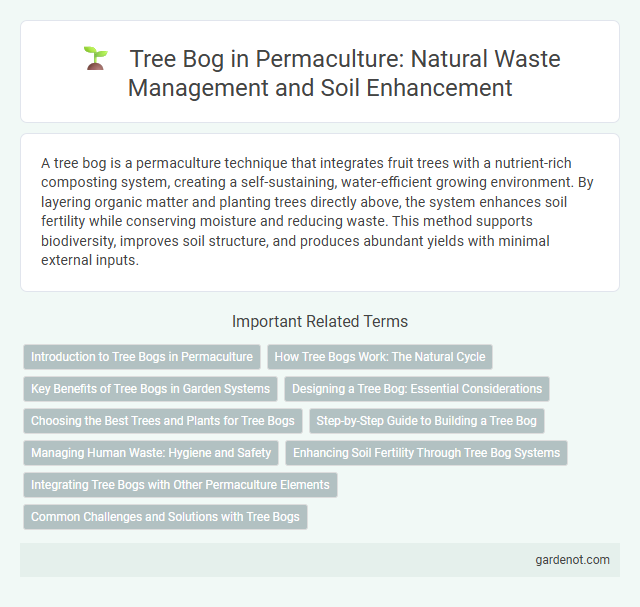A tree bog is a permaculture technique that integrates fruit trees with a nutrient-rich composting system, creating a self-sustaining, water-efficient growing environment. By layering organic matter and planting trees directly above, the system enhances soil fertility while conserving moisture and reducing waste. This method supports biodiversity, improves soil structure, and produces abundant yields with minimal external inputs.
Introduction to Tree Bogs in Permaculture
Tree bogs in permaculture are innovative water-retentive systems designed to support fruit trees by combining wastewater treatment with organic cultivation. These systems use layers of gravel and soil colonized by beneficial microbes and plants to filter greywater while providing deep-rooted trees with nutrient-rich moisture. The integration of natural filtration and permaculture principles enhances soil fertility, biodiversity, and sustainable water management in agroecosystems.
How Tree Bogs Work: The Natural Cycle
Tree bogs operate by integrating deep-rooted plants and trees with a layered system of organic matter, allowing water to be naturally absorbed, filtered, and recycled. Microorganisms in the decomposing organic layers break down waste and convert nutrients into bioavailable forms, supporting healthy plant growth. This natural cycle creates a self-sustaining ecosystem that enhances soil fertility, conserves water, and promotes biodiversity in permaculture designs.
Key Benefits of Tree Bogs in Garden Systems
Tree bogs enhance garden systems by efficiently filtering graywater through layered soil and plants, transforming waste into nutrient-rich inputs for fruit and perennial trees. Their water retention capacity supports drought resilience while promoting biodiversity by creating habitats for beneficial microorganisms and insects. Integrating tree bogs reduces external water and fertilizer needs, fostering sustainable, low-maintenance ecosystems in permaculture landscapes.
Designing a Tree Bog: Essential Considerations
Designing a tree bog involves selecting appropriate tree species that thrive in wet, nutrient-rich conditions while ensuring proper water flow management to prevent stagnation. Incorporating layers of organic mulch, compost, and soil substrates optimizes water retention and nutrient cycling, enhancing soil fertility and plant health. Strategic placement within the landscape maximizes sunlight exposure and integrates with existing water catchment systems for sustainable permaculture design.
Choosing the Best Trees and Plants for Tree Bogs
Selecting drought-tolerant trees like willow or alder enhances water filtration in tree bogs by promoting deep root growth and nutrient uptake. Incorporating native plants such as cattails, sedges, and rushes supports local biodiversity and improves soil stabilization while efficiently absorbing excess nutrients. Opt for a diverse mix of species adapted to wet and saturated conditions to maintain ecosystem resilience and optimize pollutant removal in permaculture tree bog systems.
Step-by-Step Guide to Building a Tree Bog
A tree bog is a sustainable permaculture system combining fruit trees with nutrient-rich composting layers to create a self-fertilizing garden. Begin by digging a deep pit, about 1.5 meters wide and 1 meter deep, then layer green waste such as grass clippings, kitchen scraps, and brown waste like straw, alternating to encourage decomposition. Plant the tree in the center, filling the pit with soil and mulch, ensuring consistent watering to promote nutrient cycling and healthy tree growth.
Managing Human Waste: Hygiene and Safety
Tree bogs offer an innovative permaculture solution for managing human waste by using deep-rooted plants like willows or comfrey to break down pathogens and nutrients safely. This system enhances hygiene by separating urine and feces, allowing for efficient composting while minimizing odors and contamination. Proper maintenance ensures waste is transformed into valuable biomass, promoting environmental health and reducing pollution risks.
Enhancing Soil Fertility Through Tree Bog Systems
Tree bog systems enhance soil fertility by integrating deep-rooted trees with nutrient-hungry wetland plants, creating a natural filtration and nutrient recycling process. The roots of these trees, such as alder or willow, fix nitrogen and improve soil structure, while the bog plants absorb excess nutrients, reducing runoff and promoting microbial activity. This synergy results in richer, more productive soil, supporting sustainable agriculture and ecosystem health.
Integrating Tree Bogs with Other Permaculture Elements
Tree bogs enhance permaculture systems by combining wastewater treatment with fruit tree cultivation, improving nutrient cycling and water retention. Integrating tree bogs with swales, rain gardens, and composting systems boosts soil fertility and biodiversity while reducing waste and irrigation needs. Coordinating tree bog placement with crop zones and animal systems maximizes resource efficiency and creates resilient, self-sustaining ecosystems.
Common Challenges and Solutions with Tree Bogs
Tree bogs often face challenges like waterlogging and pest infestation, which can hinder plant growth and soil health. To address waterlogging, implementing proper drainage systems such as gravel layers or swales helps maintain optimal moisture levels. Pest management involves introducing beneficial insects and using natural repellents to protect the ecosystem while preserving biodiversity in permaculture designs.
Tree bog Infographic

 gardenot.com
gardenot.com